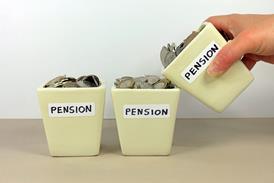The Strathclyde Pension Fund has nearly doubled its investment in emerging markets debt as part of a drive to diversify its portfolio and participate in 'the growth story' of emerging economies.
EMD could be an attractive source of return for yield-starved investors. The yield on JPMorgan’s Emerging Market Bond Index, which tracks hard currency debt, currently stands at 6.37 per cent, while the yield on the JPMorgan Government Bond Index-Emerging Markets Global Diversified Traded Index is 6.34 per cent.
Strathclyde, which uses emerging markets specialist asset manager Ashmore, first invested £300m in EMD at the close of 2016.
The market is much less volatile than common perception
Paul Greer, Fidelity International
It has agreed to add a further £210m of “derisking proceeds” to its EMD mandate, according to fund committee documents. The allocation sits in its "short-term enhanced yield" portfolio.
The asset class offers diversification benefits and access to high growth, according to experts. However, investing in emerging markets does carry additional risks, and can create hazards for schemes looking to observe environment and social governance standards.
Searching for alternatives to equities
A 2014 review of Strathclyde’s investment strategy culminated in a decision to derisk the portfolio. As part of that, in December 2017 the fund used derivatives to reduce its equity exposure to 57.5 per cent from 67.5 per cent.
Richard McIndoe, head of pensions at Glasgow City Council, the administering authority for the £21.2bn fund, said that the increased allocation to the asset class was part of a push to find yield. The scheme has also added £420m to its multi-asset credit mandates.
Yields in EMD have climbed in recent months. For example, the yield on the JPMorgan GBI-EM Global Diversified Traded Index stood at 6.34 per cent as at May 9, compared to 6.07 on January 9.
“Everybody’s looking for yield these days, and it’s hard to find,” McIndoe said. “Emerging markets do appear to present the likelihood of delivering for the foreseeable future.”
He added: “It fit the bill for what we’re trying to achieve, which is reduce equities, and find other things that produce a more consistent yield… and consistent return.”
Can schemes reconcile ESG with EM?
The Strathclyde fund has pledged to incorporate environmental, social and governance analysis “into investment analysis and decision-making processes”, according to committee documents. Yet responsible practices can be harder to monitor and enforce in developing economies.
McIndoe admitted that ESG had been “part of the conversation” as the fund considered EMD, recognising that “the standards aren’t as high” in developing economies.
Nishant Upadhyay, head of global emerging markets at HSBC Global Asset Management, argued that while developing economies can present problems for investors with regards to ESG, developed markets contain similar hazards.
“Of course, lower down the developed scale and the developing scale, by definition, there will be greater concerns,” he said.
As of February, the scheme’s mandate had exposures to countries such as Venezuela, which is in the midst of economic and political turmoil.
Upadhyay said that in cases like these, investors have to decide between their ESG concerns and “the extra yield” offered by investment in such a market.
“Usually when you have that degree of governance concern, that is actually reflected in market pricing,” he added.
Ashmore, the fund’s EMD manager, is a signatory to the Principles for Responsible Investment, a United Nations-backed network that supports investors seeking to engage with ESG. No spokesperson from the manager was available for comment.
Not as risky as you might think
According to investment manager Fidelity International, as of last month, 39 per cent of returns from EMD were idiosyncratic.
This is the rate of return that can be specifically attributed to the asset class, and not factors common to other investments.
Paul Greer, portfolio manager at Fidelity International, said that EMD offered access to the “high growth story” of developing economies.
Positive EMD performance: Will it last?
More than four years have passed since the taper tantrum, when the US Federal Reserve started to gradually tighten its quantitative easing programme, leading to investor panic and sell-off in some emerging markets.
In January, the World Bank predicted that global economic growth would reach 3.1 per cent in 2018. Emerging market growth was expected to hit 4.5 per cent, compared to developed market growth of 2.2 per cent.
Currency volatility and politics are inherent risks of investing in EMD, according to Greer, “but you do get paid for taking that risk in the long term,” he said.
“The market is much less volatile than common perception,” he added.














